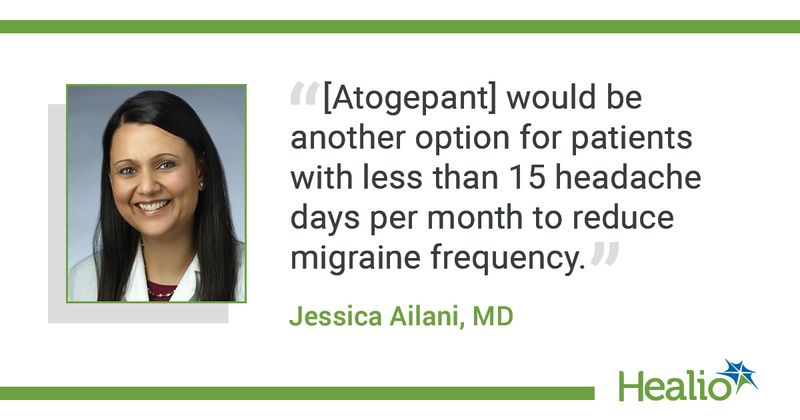Q&A: Atogepant decreases monthly migraine days in phase 3 trial
Atogepant demonstrated “clinically meaningful and statistically significant” improvement for the primary endpoint of decreasing the mean number of monthly migraine days compared with placebo, according to results of a phase 3 trial.
Researchers observed this improvement across all doses of atogepant (AbbVie) administered, including 10 mg, 30 mg and 60 mg. Specifically, 56% to 61% of patients treated with atogepant achieved a 50% or greater decrease in the number of mean monthly migraine days compared with 29% of patients treated with placebo, study results showed. The agent also resulted in statistically significant improvement for all secondary endpoints at doses of 30 mg and 60 mg. Researchers presented the findings at the American Headache Society Virtual Annual Scientific Meeting.

Healio Neurology spoke with Jessica Ailani, MD, associate professor of neurology at MedStar's Georgetown University Hospital and director of the MedStar Georgetown Headache Center in Columbia, Md., to learn more about the results seen with atogepant.
Healio Neurology: What prompted the development of atogepant?
Ailani: Atogepant was developed when the gepants were first being investigated for migraine treatment in the early part of the 2000s. Unfortunately, after development of the molecule, further studies on atogepant were not pursued; the gepants were put aside due to liver safety questions that arose when telcagepant was investigated for migraine prevention. However, the interest in gepants remained, and dedicated scientists in the field determined that the molecular structure of atogepant was different enough from telcagepant that further investigation for migraine prevention was warranted. As a clinician, I am reminded every day by patients that there is a need for newer treatment options for migraine, ones that work differently, that works faster, than are better tolerated. I am glad these scientists did not give up so that we could continue to study new options for the patients we see day in and out who may not find migraine freedom from their current regimen.
Healio Neurology: How does this agent fit into the landscape of available preventive treatments for migraine?
Ailani: If atogepant is approved by the FDA for the prevention of migraine, this would be another option for patients with less than 15 headache days per month to reduce migraine frequency, in a once-daily oral form, that allows for fast onset of efficacy with a good tolerability profile. Patients who are getting close to family planning, or prefer an oral medication, or for those who find gepants to be an effective acute option, these would all be patients I would consider a gepant for prevention.
Healio Neurology: What do the phase 3 results of the ADVANCE trial demonstrate about its efficacy?
Ailani: The phase 3 trial evaluating atogepant 10 mg, 30 mg and 60 mg for the preventive treatment of migraine demonstrated that all three doses were well tolerated and effective in reducing migraine frequency compared with placebo. Both 30 mg and 60 mg met all additional secondary endpoints, which included several endpoints focused on quality of life measures. Those measures ask the questions that are important to our patients: Are you improving with treatment and more functional?
Healio Neurology: What are the next steps for this agent?
Ailani: Currently, atogepant is being evaluated as a preventive treatment in chronic migraine.
Reference:
Ailani J. Atogepant significantly reduces mean monthly migraine days in the phase 3 trial (ADVANCE) for the preventive treatment of migraine. Presented at: American Headache Society Annual Scientific Meeting; June 3-6, 2021 (virtual meeting).

